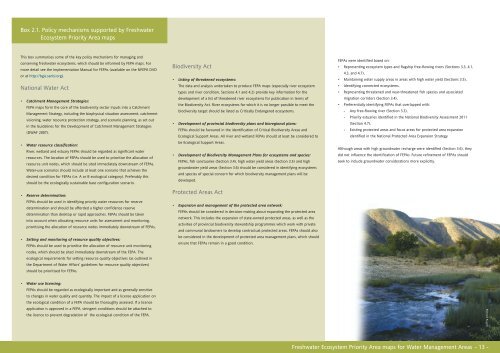NFEPA Atlas 5.3_20111025_FINAL.indd - Biodiversity GIS - SANBI
NFEPA Atlas 5.3_20111025_FINAL.indd - Biodiversity GIS - SANBI
NFEPA Atlas 5.3_20111025_FINAL.indd - Biodiversity GIS - SANBI
- No tags were found...
Create successful ePaper yourself
Turn your PDF publications into a flip-book with our unique Google optimized e-Paper software.
Box 2.1. Policy mechanisms supported by FreshwaterEcosystem Priority Area mapsThis box summarises some of the key policy mechanisms for managing andconserving freshwater ecosystems, which should be informed by FEPA maps. Formore detail see the Implementation Manual for FEPAs (available on the <strong>NFEPA</strong> DVDor at http://bgis.sanbi.org).National Water Act• Catchment Management Strategies:FEPA maps form the core of the biodiversity sector inputs into a CatchmentManagement Strategy, including the biophysical situation assessment, catchmentvisioning, water resource protection strategy, and scenario planning, as set outin the Guidelines for the Development of Catchment Management Strategies(DWAF 2007).• Water resource classification:River, wetland and estuary FEPAs should be regarded as significant waterresources. The location of FEPAs should be used to prioritise the allocation ofresource unit nodes, which should be sited immediately downstream of FEPAs.Water-use scenarios should include at least one scenario that achieves thedesired condition for FEPAs (i.e. A or B ecological category). Preferably thisshould be the ecologically sustainable base configuration scenario.• Reserve determination:FEPAs should be used in identifying priority water resources for reservedetermination and should be afforded a higher confidence reservedetermination than desktop or rapid approaches. FEPAs should be takeninto account when allocating resource units for assessment and monitoring,prioritising the allocation of resource nodes immediately downstream of FEPAs.• Setting and monitoring of resource quality objectives:FEPAs should be used to prioritise the allocation of resource unit monitoringnodes, which should be sited immediately downstream of the FEPA. Theecological requirements for setting resource quality objectives (as outlined inthe Department of Water Affairs’ guidelines for resource quality objectives)should be prioritised for FEPAs.<strong>Biodiversity</strong> Act• Listing of threatened ecosystems:The data and analysis undertaken to produce FEPA maps (especially river ecosystemtypes and river condition, Sections 4.1 and 4.2) provide key information for thedevelopment of a list of threatened river ecosystems for publication in terms ofthe <strong>Biodiversity</strong> Act. River ecosystems for which it is no longer possible to meet thebiodiversity target should be listed as Critically Endangered ecosystems.• Development of provincial biodiversity plans and bioregional plans:FEPAs should be favoured in the identification of Critical <strong>Biodiversity</strong> Areas andEcological Support Areas. All river and wetland FEPAs should at least be considered tobe Ecological Support Areas.• Development of <strong>Biodiversity</strong> Management Plans for ecosystems and species:FEPAs, fish sanctuaries (Section 3.4), high water yield areas (Section 3.5) and highgroundwater yield areas (Section 3.6) should be considered in identifying ecosystemsand species of special concern for which biodiversity management plans will bedeveloped.Protected Areas Act• Expansion and management of the protected area network:FEPAs should be considered in decision-making about expanding the protected areanetwork. This includes the expansion of state-owned protected areas, as well as theactivities of provincial biodiversity stewardship programmes which work with privateand communal landowners to develop contractual protected areas. FEPAs should alsobe considered in the development of protected area management plans, which shouldensure that FEPAs remain in a good condition.FEPAs were identified based on:• Representing ecosystem types and flagship free-flowing rivers (Sections 3.3, 4.1,4.3, and 4.7),• Maintaining water supply areas in areas with high water yield (Sections 3.5),• Identifying connected ecosystems,• Representing threatened and near-threatened fish species and associatedmigration corridors (Section 3.4),• Preferentially identifying FEPAs that overlapped with:- Any free-flowing river (Section 3.3),- Priority estuaries identified in the National <strong>Biodiversity</strong> Assessment 2011(Section 4.7),- Existing protected areas and focus areas for protected area expansionidentified in the National Protected Area Expansion Strategy.Although areas with high groundwater recharge were identified (Section 3.6), theydid not influence the identification of FEPAs. Future refinement of FEPAs shouldseek to include groundwater considerations more explicitly.• Water use licensing:FEPAs should be regarded as ecologically important and as generally sensitiveto changes in water quality and quantity. The impact of a license application onthe ecological condition of a FEPA should be thoroughly assessed. If a licenceapplication is approved in a FEPA, stringent conditions should be attached tothe licence to prevent degradation of the ecological condition of the FEPA.Richard BuganFreshwater Ecosystem Priority Area maps for Water Management Areas - 13 -
















